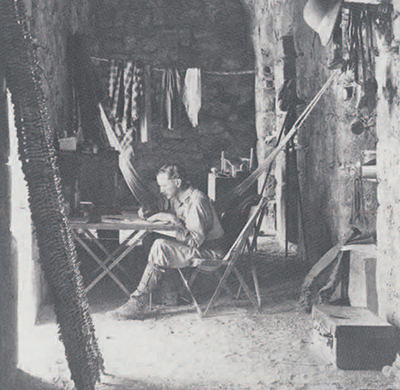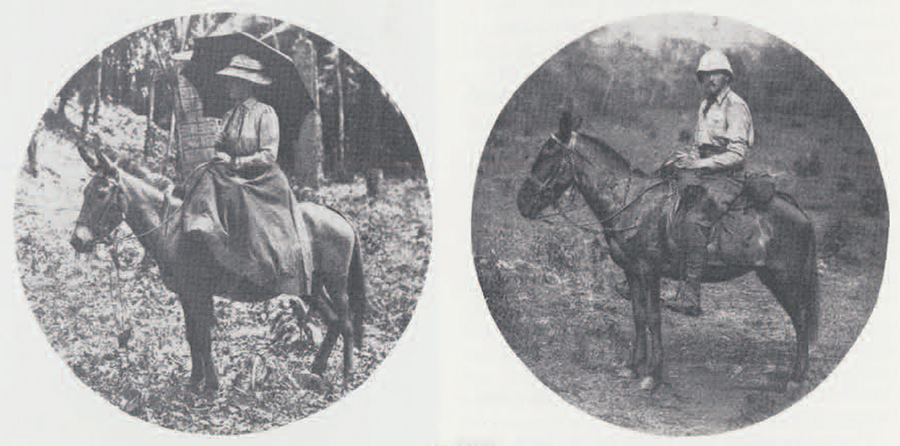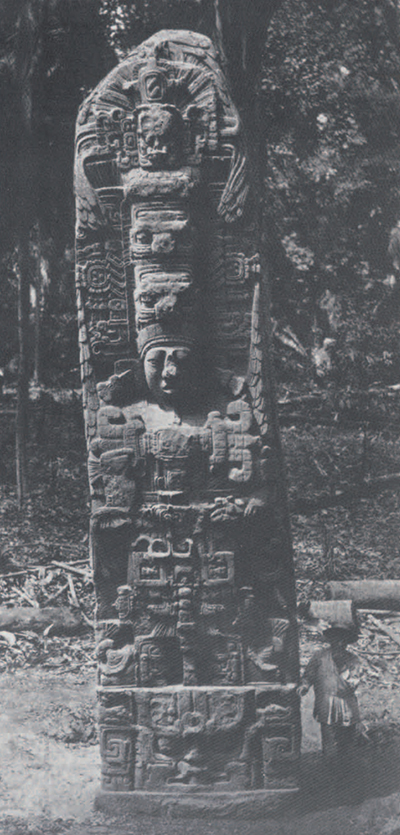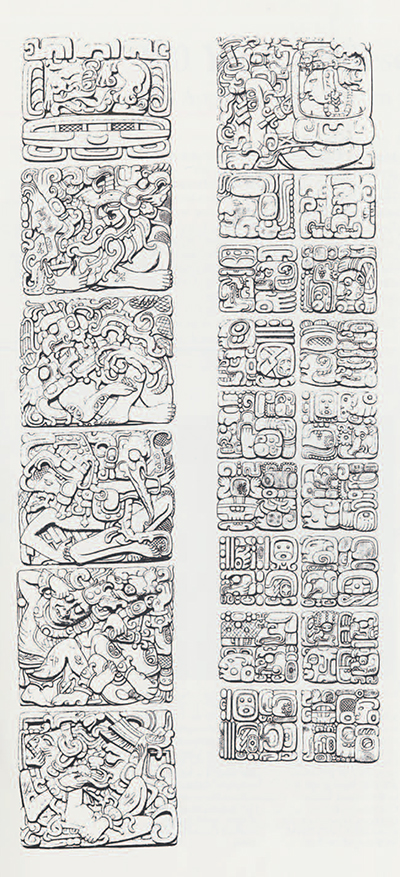
A century ago the splendid ruins of Maya civilization, first made famous by the travel accounts of John Lloyd Stephens and the illustrations of Frederick Catherwood published nearly fifty years previously, were the subjects of much speculation but little scientific knowledge. Today all that has changed due to the efforts of scholars in archaeology, linguistics, ethnohistory, and allied disciplines over the past one hundred years. But the foundations of our present knowledge of Maya civilization were laid by Alfred P. Maudslay (Fig. 1), whose explorations and research conducted near the end of the 19th century (1881-1894) mark the beginning of the modern era of Maya research.
The results of Maudslay’s pioneering investigations were published between 1889 and 1902 as the archaeological component of Biologia Centrali-Americana; or, Contributions to the Knowledge of the Fauna and Flora of Mexico and Central America (edited by F. Duncane Godman and Osbert Salvin). Long out of print, these historically important publications and the invaluable archaeological records they contain were recently reprinted in four volumes (two of text and two of illustration) under the direction of Dr. Francis Robicsek and are now available from the University of Oklahoma Press. This is an appropriate occasion to review briefly Maudslay’s significant contributions to the development of Maya research.
Alfred Percival Maudslay was born at Tunbridge Wells on March 18, 1850. His father and grandfather were prominent English engineers and inventors. Educated at Harrow and Trinity Hall, Cambridge, where he received a degree in natural sciences in 1872, Maudslay initially planned to study medicine. But this ambition succumbed to his love of travel and exploration, especially in tropical climes. After leaving school, he journeyed with his brother to the Caribbean, Central America, and Mexico before sailing to San Francisco. It was during this trip that he met his future wife, Anne Cary Morris of Morristown, New Jersey, a granddaughter of Gouverneur Morris, one of the framers of the U.S. Constitution.
The next year (1873), Maudslay returned to the West Indies where he took a temporary position as private secretary to the governor of Trinidad. When the governor was reassigned to Queensland, Maudslay continued his position in the Far Pacific where he ultimately served with distinction in a variety of posts in Fiji, Tonga, and Samoa until 1880.

In 1881, desirous of returning to the American tropics, Maudslay journeyed to Guatemala. Arriving at the Caribbean port of Livingston in January of that year, he traveled by steam launch up the Rio Duke to Lake Izabal where he disembarked and made his way overland by mule across the Sierra de las Minas and along the old Colonial road through the Motagua Valley. Although he was guided by Stephens’ account, Maudslay had no plans to pursue Maya archaeology until his first visit to a Maya site, Quirigua, which is located on the flood plain of the Motagua River very near the road to Guatemala City. In his own words:
“I was naturally anxious and expectant on this my first visit to a Central American ruin, but it seemed as though my curiosity would be ill satisfied, for all I could see on arrival was what appeared to be three moss-grown stumps of dead trees covered over with a tangle of creepers and parasitic plants . . We soon pulled off the creepers, and . . . set to work to clear away the coating of moss. As the curious outlines of the carved ornament gathered shape it began to dawn upon me how much more important were these monuments, upon which I had stumbled almost by chance, than any account I had heard of them had led me to expect. This day’s work induced me to take a permanent interest in Central American Archaeology, and a journey which was undertaken merely to escape the rigours of an English winter has been followed by seven expeditions from England for the purpose of further exploration and archaeological research.” (Biologia CentraliAmericana, Vol. 11:2)
All eight of his expeditions were carried out under the most difficult conditions, transporting literally tons of photographic equipment, casting plaster, and other supplies by mule train into areas that have only recently become easily accessible. Maudslay’s wife accompanied him on his last journey to the Maya area in 1894. That experience was the subject of a delightful chronicle jointly authored by husband and wife (Fig. 2), A Glimpse at Guatemala (1899), that remains a vivid and fascinating description of a vanished time in Central America.

(Biologia Centrali-Americana Pl .22)
The results of Maudslay’s research, published in the Biologia Centrali-Americana, centered on thirteen sites. Although seven of these sites— Ixkun, Yaxche, Rabinal (Cayup), Chacujal, Guatemala-Mixco (Kaminaljuyn), Utatlan, and Iximche— are only briefly described, the remaining six sites— Copan, Quirigua, Menché (Yaxchilan), Chichen Itzá, Tikal, and Palenque— are presented in considerably more detail. Maudslay’s narratives usually included background information and history for each site, a description of his visits and research, detailed descriptions of principal structures or other notable features, and descriptions of the principal monuments. The one volume of text is accompanied by two volumes of illustration (in addition to detailed figures in text) that present site maps, photographs of the principal structures and monuments (Fig. 3), and the famous drawings of each monument rendered by Anne Hunter under Maudslay’s supervision (Fig. 4). The record provided by these photographs and drawings is unique and invaluable, in many cases providing sculptural and epigraphic details that, due to the vicissitudes of time and human activity, no longer exist.
These pioneering contributions to Maya research established Maudslay’s work as fundamental to subsequent progress within the discipline. His explorations succeeded in uncovering new sites and monuments. He was the first Westerner to reach Yaxchilan (then termed Menché), although in an incident that well illustrates his character, Maudslay offered the credit for this discovery to M. Désiré Charnay who arrived in the ruins a day or two later.
By carefully documenting his discoveries, Maudslay has left an invaluable legacy that continues to be a primary source for scholars. These records include site maps and both plan and section drawings of buildings, all rendered to an amazing degree of accuracy considering the difficult and primitive conditions Maudslay endured. In addition, he often carefully recorded the dimensions of structures and described various construction techniques. This information was based on surveys of the sites he visited, which included detailed examinations of surface remains of buildings. In some cases, as at Chichen Itzá, he documented structural information exposed in excavations of previous explorers (and thereby provides the only record of such excavations). In other cases, Maudslay directed his own excavations, most notably at Copan and Quirigua, and accurately recorded the information thus revealed in plan and section drawings.
Perhaps the most significant of all Maudslay’s accomplishments is his record of Maya sculptured monuments and their inscriptions. The primary documentation was with photographs. produced by a large format camera and reproduced in oversized plates up to 9 x 111/4 inches (Fig. 3). These, together with the monument drawings prepared by Anne Hunter (Fig. 4) and molds painstakingly produced by papier-mache and plaster, all somehow transported out of the jungles of Guatemala to be cast in England, provided the first significant corpus of Classic Maya art and inscriptions. This furnished scholars with an immediate and critical source for the decipherment of Maya hieroglyphic texts. While the initial stages in decipherment were based on later (Post-classic) codices, Maudslay’s documentation provided the keys to the first readings of Classic period calendrical texts. And today, although subsequent compilations of Classic inscriptions have superseded this record in scope—beginning with Sylvanus G. Morley’s Inscriptions of the Peters (1937-38) and continuing with Ian Graham’s Corpus of Maya Hieroglyphic Inscriptions (still being published) — none have approached the quality of Maudslay’s photographs or the artistic merit of Anne Hunter’s drawings.

In addition to his contributions to Maya archaeology and epigraphy, Maudslay was a true pioneer in the application of historical sources to Maya archaeological situations. This is best exemplified by his studies of the Spanish Conquest period highland sites of Utatlan and Iximche, used to check the veracity of Spanish accounts of the conquest of the Quiche and Cakchiquel Maya states. The town of Chacujal, near Lake Izabal and mentioned by Cortes in his description of the march from Mexico to Honduras in 1524-25, was identified by Maudslay as the archaeological site known as Pueblo Viejo on the Rio Tinaja, based on its matching “exactly to the requirements of the description given by Cortes.”
Although he never thought of himself as anything but an amateur, Maudslay made a series of valid scholarly interpretations based on the data he collected. Some of these findings were direct, but he seems to have preferred to stimulate the work of others, suggesting several promising leads in Maya epigraphy to his contemporaries. His own zeal to find and record Maya inscriptions led him in 1886 to identify and name the Initial Series, later recognized as Long Count calendrical dates by Ernst Förstemann in 1894. Maudslay also correctly deciphered the Maya glyph for the number twenty and appears to have independently established the reading order of the inscriptions, although he was not aware of Cyrus Thomas’s discovery of the left-to-right glyphic sequence made four years previously (1882). Most scholars today believe that Maudslay made the first suggestion to Joseph Goodman that led to his decipherment of the head variant numerals used in place of the more common bar-and-dot notation in some calendrical texts. Certainly Maudslay’s encouragement of Goodman’s work, most appropriately commemorated by the inclusion of Goodman’s treatise on Maya calendrics as an appendix (volume four) of Biologia Centrali-Americana, paid significant dividends. It was Goodman, an American newspaperman best remembered for hiring Mark Twain to work for Virginia City’s newspaper, who first worked out the accepted correlation of Maya and Gregorian calendars (which was subsequently fine-tuned by later scholars and is thus known today as the Goodman-Martinez-Thompson or GMT correlation).
Finally, it may be mentioned that Maudslay sponsored or encouraged research into other important aspects of Maya civilization. For example, it was through his efforts that Adela Breton was able to record the now almost entirely vanished frescoes at Chichen Itzá. Maudslay’s own interest in ethnohistory led him to translate the most important account of the Spanish Conquest, that by Bernal Diaz del Castillo.
But the most enduring and significant of Maudslay’s pioneering research remains his greatest legacy for archaeologists, art historians, and epigraphers: the definitive record of the sculptured monuments he so laboriously photographed. Beginning with Ernst Förstemann’s reading of the Long Count dates on seven Copan stelae, this record has been used as a basic resource for scholars who have continued to make substantial progress in the decipherment of Maya writing. And because it is a record that can never be duplicated, Maudslay’s contribution to Biologia Centrali-Americana will remain an invaluable resource for future generations of Maya scholars, who are thus greatly indebted to all concerned for reproducing this version.
